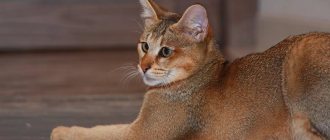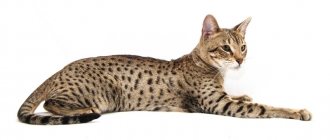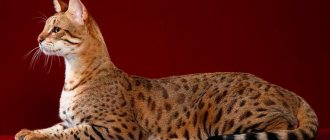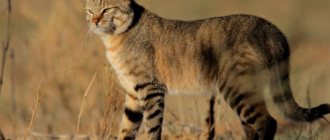SAVANNAH KITTENS FOR SALE HERE
Exotic Savannah cats are considered one of the rarest and most expensive in the world. These are incredibly beautiful, graceful and intelligent animals, with behavior more reminiscent of dogs.
Our Savannah cattery (Ashera cat) offers you a unique opportunity to purchase an excellent, purebred kitten that will make your home happy and become a living and purring source of joy for many, many years!
Video
* We invite you to watch a video about the Savannah . In fact, in front of you is a playlist in which you can select and watch any of 20 videos about a given cat breed by simply clicking on the button in the upper right corner of the window. In addition, the material contains quite a lot of photos. By looking at them you can find out what Savannah looks like.
In this article:
|
Hybrid kittens/cats
“Cats, by their very existence, refute the assertion that everything in the world was created for humans.” /Paul Gray/
We deliver kittens of the following breeds: Chausie, Savannah, Bengal F2, Alc, anywhere in the world, by train or plane
Parents of hybrid kittens were tested for leukemia, immunodeficiency and coronavirus with negative results. Before purchasing a kitten, please read the purchase agreement
History of the origin of savannas
cat breed was created as a result of an accidental cross between a Serval and a domestic cat in 1986 in the United States. Here is how it was. One fairly well-known breeder in her circles, Judy Frank, who had been breeding bush cats for a long time, decided to “renew the blood” of her pets and took a male serval from her friend for mating. Everything turned out great for the animal, but along with the purebred cats, the serval also covered the breeder’s domestic cat.
Judy gave the only kitten that was born after an unauthorized mating to Susie Woods, the same friend who borrowed the serval, as a thank you. By the way, it was she who gave the kitten the nickname Savannah. Susie herself was not a professional breeder, which, however, did not stop her from conducting an experiment on crossing Savannah with her domestic cat and even writing several articles on this topic.
Experiments are experiments, but the main contribution to the development of the breed was made by another person - Patrick Kelly. A man who had long been interested in exotic cats purchased a kitten from Susie Woods and attracted an experienced breeder of Bengal cats, Joyce Sroufe, to breed the new breed. After a decade of painstaking work, in 1996 they presented the International Cat Association (TICA) with new unusual animals with a unique leopard color.
The Savannah breed was officially registered and recognized in 2001. As for the breeder Joyce Sroufe, she received the status of the founder of an elite cat “clan” and world fame.
Cat breeds
Did you think you knew everything about cat breeds? Test your knowledge on the official website of German natural pet food Bosch. We present an extensive catalog of various cat breeds. The section contains more than 70 reference articles. The names of cat breeds with detailed descriptions and high-quality photos will be of interest to both experienced cat lovers and those who are just thinking about buying an animal.
If you do not want to search alphabetically, write the desired cat breed and use the search bar. Each description of cats with photographs is divided into several parts: a brief information about the breeding of the breed, then a detailed description of the physiological characteristics - for example, the shape of the head, ears and eyes, the size of the body, the nature of the color, the length of the coat, etc.
Savannah - description of the breed
When starting to describe the savannah, it is worth noting that felinologists have developed three conventional levels of the breed - F1, F2, F3. It follows from this that Savannah F1 is the level that is considered the most purebred and, accordingly, the most expensive (offspring obtained by crossing a serval and a domestic cat). Savannah F2 is the second hybrid generation (offspring obtained from crossing Savannah F1 with a domestic cat). Savannah F3 is the third hybrid generation (offspring obtained from Savannah F2 and a domestic cat).
In the first case, the number of serval and domestic cat genes is 50/50 percent, in the second 30/70 percent, in the third - 13/87 percent. There may also be lower levels - F4, F5, F6, F7, F8, but only the first three are recognized by breeders and felinologists, since they believe that the Savannah generation ends there.
The cat is quite tall on its legs, and its body is much longer and more graceful than that of most domestic cats. The limbs are very long and muscular. The feet are usually oval in shape, with the front feet generally shorter than the back feet. The toes are quite large and the nails are long and hard.
The tail is of medium length and thickness, starting from the hock joint, slightly tapering from the base to the end. The Savannah's physique gives the illusion of great weight, but its weight can be either 5 kg or 12 kg, which depends on gender and age.
The color is usually silver, brown, smoky with darker contrasting oval or round spots, like leopards. In the area of the head and shoulder blades there are parallel dark pigment stripes.
The coat is short, dense, smooth, rough. The head is wide and rather long, with a triangular muzzle, elongated nose and small chin. The eyes are large, close-set, almond-shaped, usually with a drooping upper eyelid. The breed standard allows iris colors of all shades of brown, green and yellow. The ears are high, exactly the same as those of a serval.
What is the difference between a Savannah and a Bengal cat?
Despite the similarities in appearance, the Savannah cat and the Bengal cat have a number of significant differences.
- The pedigree of Bengal cats originates from the Far Eastern cats, and in the savannas - from African servals.
- If you look closely at Savannahs and Bengals, differences in the coloring of the skin are visible to the naked eye. In Bengals it is dotted with dark spots of three different colors. Savannahs have spots of the same tone.
- Distinctive features are manifested in the structure of the body. The Bengal breed has a compact body, like an American football player. These are cats with small ears and large round eyes. But Savannah is compared to a tall basketball player. They have big ears.
Popular savannah colors
As already mentioned, the coat of the savannah is quite short with somewhat harsh and coarse guard hairs and a shorter and softer undercoat. In areas where the spots are located, the hairs are usually slightly longer and softer.
In the savannah there are only four main colors:
- Brown;
- Tabby spotted;
- Smokey black;
- Spotted silver.
At the same time, the standard shades of spots of the characteristic “leopard print” are dark brown and black. The presence of spots of other colors is strictly prohibited and is a reason for the concept of disqualification.
The shape of the spots is much preferable to oval, somewhat elongated, although rounded is quite acceptable, but their outline must be graphic and clear. The spots in the area of the back are usually larger, and in the area of the chest, legs and head - smaller. There must also be parallel contrasting stripes running from the back of the head to the shoulder blades.
Also, the color and appearance of the savannah depends on what level a particular individual belongs to. For example, F1 hybrids are most similar to servals and have the same large size. F2 hybrids will already be smaller, and F3 savannahs will be even smaller.
Savannahs are most often disqualified for incorrect behavior (too aggressive, or, conversely, too cowardly, unwilling to make contact), rather than for other defects. Congenital defects of savannahs (color defects, rosette spots, medallion spots, small ears, extra toes) also do not go unnoticed, but experts are more loyal to them.
How to choose a kitten
Before purchasing a Savannah kitten, you should look at the parents. The main thing you should pay attention to is the living conditions, pedigree and order of the kitten’s generation.
Important! A kitten should be taken as a pet no earlier than the 3rd or 4th generation.
The pet's parents must be purebred, the owner of the kennel must have pedigrees for each manufacturer and veterinary passports confirming the presence of scheduled vaccinations. Animals should not live in cramped conditions.
The optimal age for purchasing a kitten is 3-4 months; by the time of sale, it must be socialized and trained to use a scratching post and litter box. The pet should rumble, purr, make contact easily and be playful. If the kitten is too aggressive, then you should refrain from buying.
A kitten should be picked up only in the presence of the breeder and with a fully drawn up contract, which provides for testing the animal for infectious diseases and the possibility of returning it if the veterinarian’s conclusion is unsatisfactory.
Character and habits of savannahs
If you believe the advertising, then the genes of the wild African relative of the savannah (serval) awaken quite rarely in these cats. Whether one should completely trust such statements is a personal matter for everyone. However, one should not discount the fact that any cats are still predators, and savannahs (for well-known reasons) are doubly predators.
Interesting fact: As experience shows, Savannahs are usually quite friendly pets, but at the same time very playful and active. Therefore, these cats are definitely not suitable for owners who see them only as sofa cushions.
One of the most important qualities of the Savannah is the passion for dominance. This trait was inherited by them from their wild ancestors and was somewhat softened by the admixture of the blood of domestic cats. It is worth noting that this passion can be successfully neutralized by sterilization. It has long been noted that cats after this operation become much more tolerant and calmer. This is especially true for individuals of the F1 and F2 levels. Therefore, F3 or F4 hybrids are better suited for a family with children. For owners who want to caress and cuddle their pet, the latter are also better suited.
Savannah cats do not like loneliness, so it is not advisable to leave them alone for a long time. Unless, of course, the potential owner is afraid of the prospect of one day returning to a completely destroyed home with scratched walls and damaged furniture. Savannahs are also often vindictive, so it is advisable to treat them much more respectfully than other cat breeds.
F1 level cats have a rather negative attitude towards strangers, which is most often warned about by loud grumbling and hissing. In relations with the owner, Serval genes are not so pronounced. A few more very characteristic features of the savannah: the choice of one owner, the dog’s loyalty to him and almost complete disregard for other family members.
Descriptions, photographs and character
For future owners of graceful creatures, the section on the character of various breeds of cats and kittens will be extremely useful. Here you can find out how your pet tends to communicate with people - affectionate and trusting or emphatically independent and even sometimes aggressive? Or perhaps kittens are future excellent hunters, playful and curious, which means it will be impossible to lock the warlike tailed one within four walls. A detailed description of the breed will help you make the right choice. We especially note that the catalog contains expensive and rare cat breeds.
Often the determining factor when choosing a pet is its appearance. Especially if you entrust the choice of a pet to children. But when looking at photos of cat breeds, do not forget that only a careful acquaintance with the description of the character can serve as a guarantee that in the future there will be no disagreements between you and a tailed family member.
Interesting facts about savannahs
Savannahs are very active cats. They will almost never lie on the sofa, because they love to run and jump. For this reason, they simply need a play corner and a large number of toys. Otherwise, walls, curtains and furniture may be seriously damaged.
Ashers are not at all afraid of water. They swim and play in ponds with great pleasure. Savannahs are very independent and proud cats. They do not like to be petted, hugged or squeezed for a long time. Individuals of the F1 level are especially intolerant of affection.
These cats become very attached to their owner, choose one for life and demonstrate their loyalty to him in every possible way. F1 hybrids are the most difficult to train because they are half serval. It is best to keep such savannas in a private house in a special enclosure, and not in an apartment.
As for training, Ushers are quite smart and intelligent in order to understand and execute commands intended for dogs (“fetch”, “come to me”, “sit”, etc.).
Thanks to the serval genes, savannahs are excellent hunters, literally one of the best. For this reason, they can sometimes hone their hunting skills on their owner and other family members. It is advisable to wean your pet from this harmful and rather dangerous habit from a young age with frequent walks, games and the acquisition of a sufficient number of different toys.
Savannah kittens not intended for breeding are usually sterilized by breeders in nurseries before the sale takes place. This is done in order to minimize the risk from the somewhat wild nature of this breed.
Character
Character is influenced by 3 main factors: parental behavior, generation, socialization. Since the breed is still at an early stage of development, animals of different generations differ significantly in character.
The first generation Savannah cat (F1 or F2) will behave more actively and even wildly. This is reflected in the nature of servals, which are characterized by jumping, hunting and tracking. Fertile F5 and F6 cats are already used for breeding. The resulting offspring has a character more familiar to all owners of domestic cats. But, nevertheless, all generations are characterized by excessive curiosity and high activity.
An interesting combination of love of freedom and easy-going characterizes all cats of the Savannah breed.
They adapt well to various conditions, show interest in things around them, and tolerate coexistence with other pets.
These cats are extremely mobile, jumping, and require a lot of space for a comfortable life. Unlike other cats, they are not only not afraid of water, but enjoy bathing. They even prefer to drink ordinary water from large containers, which apparently remind them of the reservoirs familiar to their ancestors. These cats do not protest when they are walked on a leash, which once again demonstrates their “dog-like” character.
The main characteristic is devotion, which is often compared to that of a dog. Wagging the tail as a greeting is also more of a dog than a cat sign.
Such cats get along with children from 5 years old (but not with toddlers), because they are calm and enjoy playing for hours on end. They have a high level of intelligence (some felinologists highlight this trait significantly) and are trainable. But they also require a lot of attention.
When raising them, it is important to take into account that they need early socialization. Kittens that communicate with people from their first days quickly get used to life in a family, learn behavior and habits. But in one litter there can be both more active and sociable kittens and more timid ones. Therefore, you need to communicate with the latter, play more actively, and encourage them more often than active, fearless kittens.
Pros and cons of savannas
The pros and cons of a particular breed are a rather subjective phenomenon, but undoubtedly worth familiarizing yourself with them in detail and remembering all the most important points.
Advantages:
- Exotic appearance and beauty;
- Curiosity;
- Mind;
- Intelligence;
- Almost dog-like devotion to one master;
- Ability to learn and train;
- Strong immunity;
- Get along well with other pets;
- Easy to care for;
- Undemanding to nutrition;
- Quick adaptation to new living conditions.
Flaws:
- Large size;
- Proud and self-willed character;
- Expensive;
- Activity and mobility;
- The need for daily long walks;
- Hazardous to very young children.
To maintain health and active muscle tone, Savannahs are highly recommended for daily walks in the fresh air, especially if the pet lives in an apartment. After all, only on the street will the animal have the opportunity to run, jump, play and thus throw out excess energy. In the warm season, savannas are not at all averse to swimming and frolicking in bodies of water, which is not so typical of the cat family.
As for maintenance, savannas (especially F1 hybrids) feel much better in a country house than in an apartment on some floor. In general, it is ideal if the animal lives in a special enclosure. It’s clear that not every owner has a country house, so you can arrange a special play area for your pet in the apartment. Moreover, in pet stores you can choose one to suit every taste and budget.
How to help a Savannah kitten get used to a new home and you faster?
Don't be nervous when you bring a Savannah kitten into your home. Place the carrier on the floor and allow the kitten to get out of it on its own. If the kitten does not want to leave the carrier, try to entice him with a feather toy. Leave the carrier in the room so that the kitten can hide in it if it gets scared.
At first, keep your Savannah kitten in a small room. Place a lounger or house in the room (the second is preferable, as it gives the kitten a sense of security), a tray, bowls of food and water, and several toys. Sit or lie on the floor at kitten level to play and socialize. Make sure your kitten knows where food and water are and make sure she gets enough to eat and drink.
Place the kitten in the litter box several times during the first few days after arrival. Use natural litter, such as wood, paper or corn. In the first few months, several trays are placed throughout the house, and if you have a multi-level apartment (house), then several trays on each floor. As the savanna matures, the number of trays is reduced.
After a day or two, open another room for the kitten to explore. After another 1-2 days, the kitten is allowed to explore the third room. And so on until he gets to know the whole house.
Gradually introduce the kitten to other pets, but only five to seven days after the kitten arrives at its new home. First, let the animals into the room where the kitten lives, and the kitten into the room where the animals live. Let them get to know each other's scent. Then you can show the animals to each other through glass or a screen. When the first emotions pass, you can try to introduce the animals personally under your control. If this is a dog, then for the first meeting it is advisable to put a muzzle on it. If animals are aggressive towards each other, then they need to be separated into their rooms and for several days they should be given things that smell like animals.
It is not recommended to introduce the savannah to a large number of people at once. This must be done gradually, as with opening all rooms of the house/apartment for inspection.
Savanna breeding
The owner of a Savannah cat planning to breed should know that all males of the breed of generations F1 - F4 are sterile, that is, incapable of reproduction or infertile. For this reason, Savannah breeding occurs exclusively on the maternal side by mating cats of the F1 - F3 levels with male African Servals.
Males of the F5 level are already quite capable of reproducing, but the purity of the breed does not benefit from this, but quite the opposite, especially since such offspring will no longer correspond to the generally accepted breed standard.
Sexual maturity in Savannahs usually occurs at 7–9 months, but when planning breeding it is better to wait until the cat is 12 months old. It is clear that the cat must be completely healthy and strong in order to bear and give birth to babies without problems.
Mating of this breed should be carried out only under the supervision of specialists from a specialized nursery. According to the rules of most clubs, before mating, a cat is given a so-called “breeding grade” at a show. The rating must be at least “Very Good”. Cats with the title “Breed Champion” and above do not need to visit an exhibition before mating.
It is also important to know that there are not many savanna species in the world yet. For this reason, breeders had no other choice but to crossbreed animals that were essentially close relatives to each other. This fact, from a genetic point of view, suggests the possibility of many genetic diseases in the breed, but this did not happen. It is difficult to name the reason here; it is possible that the wild blood of the serval did its job.
Interesting fact: There are actually not many nurseries in the world offering to purchase Savannah kittens. For this reason, when purchasing a kitten from a private breeder, its owner is unlikely to receive adequate guarantees of the quality of the breed.
Today, the highest quality Asher gene pool is offered by the A1 SAVANNAHS nursery in the USA, which was organized by Joyce Sroufe.
There are only four specialized nurseries in the post-Soviet space:
- "Savannah Premium" (St. Petersburg);
- "L'unicorne" (Moscow);
- "Royal Cats", "Luxury Cats" (Kyiv).
At what age can you adopt a Savannah kitten to a new home?
No breeder who respects himself, his clients and pets will agree to give a kitten under the age of 3 months to a new home, and show-class and Savannah kittens of the F1-F4 generation until they are 4-5 months old.
If the seller assures that the buyer will be able to raise, for example, 1.5-2 month old Savannah dogs himself, it is strongly recommended not to contact such a breeder. Savannahs, like any other animal, need to get the most out of their mother. In addition, time is needed for vaccination and quarantine. Savannahs over five months old can be transported immediately after reaching agreement with the seller.
Savannah care
A short list of rules that the owner of a savannah will have to follow looks something like this:
- Walk often and a lot;
- Pay a lot of attention;
- Accept the inevitable destruction in your home.
Raising a Savannah cat is also impossible without a scratching post. When purchasing this important cat device, you should definitely take into account the size of the animal, because flimsy and small products intended for the most ordinary cats will not last very long.
Also, before bringing a cheetah kitten into your home, you should take care of the correct trash cans with tight-fitting lids. This is necessary so that very curious savannahs do not rummage through them in search of their cat treasures.
Now let's talk about care. Caring for the Savannah's coat requires minimal attention - brushing once a week, and during the shedding period - daily. However, combing can be replaced by wiping the coat with a damp, alcohol-free cloth.
Asher's claws require regular trimming, otherwise the house is guaranteed to be a complete mess. Cats with an overly capricious character can undergo laser onychectomy (removal of claws on the front paws using special equipment). This procedure is not cheap, but buying new furniture and accessories for your home will be even more expensive.
Interesting fact: Savannahs are bathed infrequently - as needed. For bathing, special cat shampoo or baby soap is usually used.
Savannahs get used to the litter box quite quickly. For smaller hybrids (F4, F5), a classic cat litter box is quite suitable. For larger hybrids (F1, F2, F3) a larger tray will be required. Cats also learn to use the outdoor toilet quite easily and can even learn to use the toilet.
Breeding and care
Descendants from crossing servals with domestic shorthair cats, Bengal, Siamese, Egyptian Mau and others are designated F1 (that is, descendants of the first generation). They have 53% blood of wild servals. All males, up to the fourth generation, are sterile. Each subsequent generation is designated by the F indicator with the corresponding numerical index. The descendants of F2 have only 29% Serval blood, and so on down the line, down to F7. The higher the percentage of Serval blood in the descendant, the more similar in appearance it will be to him. Savannahs designated F1-F3 are descendants of earlier generations. For them, the percentage of Serval blood is indicated in parentheses after the generation designation. They are the ones most valued by breeders of the breed and those wishing to acquire kittens.
To overcome physiological and behavioral problems, partners selected for mating are kept together from childhood. Significant biological differences between breeding breeds also affect the bearing of offspring.
This breed is unpretentious. Savannahs do not require special care. You just need to brush them regularly. It is advisable to equip a special enclosure, spacious enough, with equipment for climbing and jumping. The enclosure should only be used for its intended purpose—for cat walks. But in no case for permanent stay, since they value freedom of movement and will not tolerate confinement.
Savannah diet
The diet of the savannah is usually determined by its origin, since the genes of a wild African predator have endowed it with a special digestive system. For this reason, the diet of such a pet should not contain either fatty fish or pork, as well as cereals and fermented milk products.
The best food for Asherah is raw chicken meat and chicken offal with the addition of raw vegetables (carrots, pumpkin, zucchini). It is worth noting that natural food can significantly extend the life of a pet - by 5 years or even more.
Interesting fact: Despite the “wild” origin of the savannah, many breeders still prefer to feed the savannah “dry”. In this case, the food should only be premium with a very low grain content.
Dry food is selected exclusively in accordance with the weight and age of the cat. It is also important to know that to support the heart, the Savannah needs to be given special vitamins with taurine. You can also buy special treats containing this substance in pet stores.
Special vitamin complexes, canned food and pastes are also sold for kittens and pregnant cats. If your Savannah cat eats dry food, you must ensure that she has constant access to clean water. The water must be changed every day.
An adult Savannah cat is fed no more than 2 times a day (breakfast and dinner). The exception to this rule is pregnant females and kittens under 4 months. Needless to say that regularly overfeeding an animal will not be beneficial at all? After all, in the wild they eat completely out of schedule and move much more than at home.
Savannah-asherah character
These are quite friendly and affectionate cats. However, they will not just lie on the couch for a long time. Therefore, they are unlikely to be suitable for people who dream of having a cat as a beautiful interior decoration. Cats are inquisitive, smart, and very active.
Representatives of this breed love to jump, love a variety of toys and frolic in the water. This cat doesn't like to sit in your arms for too long - she can't stand being restrained. However, the cat becomes very attached to only one owner and demonstrates its devotion to him in every possible way. Sometimes this attachment creates difficulties - the savannah cannot practically be left to strangers during the holidays.
Savannahs are a great pet for older children. A cat may be offended and not come out of hiding for a long time if it was punished undeservedly or its favorite toy was taken away, but it will not take revenge.
Education and training
Savannahs constantly need to maintain health and muscle tone. Therefore, before walking an animal, you should first accustom it to a leash.
Representatives of this species love novelty, are always ready to learn and are easy to train. After several training sessions, Savannah easily fulfills the command “fetch” and “sit”, and is able to walk on a leash and give a paw.
Even being domesticated, these individuals from the savannah family have not lost their natural hunting instinct. Often they can demonstrate skills and abilities even on their owner. The cat should be weaned from this dangerous habit at an early age. You need to walk the kitten more often, do training, and buy funny toys more often - mice, birds and other small animals.
Care and maintenance
The owner of the Savannah should be patient and prepare not only for frequent walking of the animal, but also for frequent disturbances in the apartment or house, since Savannah Ashers are extremely jumpy. Therefore, you should think through the interior of your home in advance and remove various small breakable items from open shelves. In addition, Savannahs love to find viewing objects on high cabinets.
To wean your cat off this fun, you can purchase an electric mat that is spread on surfaces.
Savannah, like any other cat breed, loves to sharpen its claws, which often affects furniture. You should purchase scratching posts, but when choosing a device, you should take into account the size of the pet - small scratching posts will quickly fail. Experts advise keeping an eye on your nails and trimming them regularly at home, but you can also resort to special nail trimming by contacting a specialist.
You should also think about trash containers in advance. Containers must be tightly closed, since representatives of this population are extremely curious and are not averse to checking containers.
Caring for a Savannah cat
Grooming
does not require special skills. It is enough to brush your pet once a week. However, during molting, this procedure should be daily. If shedding is intense, you need to brush the coat several times a day. Some breeders suggest simply wiping the fur with a damp cloth. Cats do not need to be bathed often, depending on the situation, although Savannahs simply adore water treatments. They take a bath with great pleasure and, as soon as possible, swim in the pool and frolic in the water with toys.
Cleaning teeth and ears
carried out depending on the degree of contamination.
These cats get used to the litter box very easily. When choosing a tray, you need to take into account the size of your pet. Interestingly, these domestic cheetahs easily master the rules of using the toilet.
The diet of domestic cheetahs corresponds to the menu of the wild serval. First of all, this is high-quality fresh raw meat of lean varieties - chicken, rabbit, beef. But it’s better not to feed your cat fish and milk.
However, natural products alone are not enough for the savannah. It is worth consulting with a veterinarian and stocking up on a special complex of vitamins, which includes taurine, to support cardiovascular activity. Dry food should also be used, but not often and alternate its varieties.
Breeders do not rule out mating males of this breed with ordinary cats
- Bengal, Ocicat, Egyptian Mau and even mongrels. Individuals aged one and a half to two years are considered ready to reproduce.
Health and illness
Savannah cats have excellent health and live about 20 years. However, savannas have birth defects - dwarfism, cleft palate, etc. Also, sometimes pets get sick with fungal and viral diseases. A malfunction in the pet’s body is manifested in its actions and behavior: the pet is lethargic, severe molting begins, there is a decrease in appetite, and very frequent involuntary urination begins.
But many health problems can be prevented if your cat is regularly vaccinated and fed properly, taken for walks, and engaged in outdoor games.
How to choose a kitten?
- Explore nurseries that sell kittens;
- Get information about vaccinations;
- Study the pedigree;
- Assess the animal’s behavior (friendliness, adequacy);
- Age 3-4 months (know how to use a tray);
- Conduct testing for hidden infections.
Sterilization of cats
If a pet was not purchased in order to reproduce in the future, then it is very important to know that sterilization or castration is a completely harmless procedure and a guarantee of excellent health and adequate behavior of the animal. The operation is performed between 10 and 14 weeks after birth. The operated animal is under the supervision of veterinarians for several days. Savannah males are operated on before they are six months old to prevent urine splashing in the house and aggressive behavior.
Diseases and health problems
The Savannah breed is characterized by simply remarkable health and immunity. Despite multiple (if not constant) cases of incest during their breeding, cats are completely free of genetic diseases as such. Geneticists and experienced breeders cite the notorious serval roots as an explanation for the reason why these cats have such strong immunity. After all, these wild African predators have been adapted to the harshest conditions since ancient times and survived as best they could, thereby training their genes.
Most of the diseases of these cats concern diseases that are widespread among all other breeds. Moreover, most of them can be easily prevented with regular veterinary examinations and timely vaccinations.
Savannahs also have a slight predisposition to the appearance of congenital external defects, which mainly affect not the health of the pet, but its breed status and the ability to take part in exhibitions. Such defects most often occur due to neglect of a pregnant cat (lack of vitamins, poor diet, etc.) or during childbirth.
Such defects usually include:
- Dwarfism;
- Hydrocephalus;
- Polydactyly;
- Cleft palate.
In very rare cases, animals can contract viral, bacterial or fungal infections. You can tell that something is wrong with your cat by changing its behavior. It follows that excessive shedding, lethargy, poor appetite, vomiting, and very frequent urination are signals that some kind of malfunction has occurred in the pet’s body.
Thanks to the same “wild” genes, savannas are prone to longevity and, with proper nutrition and adequate care, can live up to 20 years.
Appearance
According to established standards, these cats have a flexible, slender, elongated body. The cat looks heavier than it actually is. It stands out for its very large, rounded ears. Limbs are long and strong. The hind legs are longer than the front legs, like those of large cats. The tail is long and straight. The short fur of a Savannah kitten is very soft and thick. The undercoat is soft, dense, evenly distributed throughout the body. Another feature is that the paws are round, small in size, and colored charcoal or dark brown. Savannah is distinguished by its noble posture and natural grace. Unlike the British, who are considered to be such “bumps” in the cat world.
Standard colors: cinnamon tabby, chocolate, gold-silver, brown.
The largest representative of domestic cats. Height at the withers is up to 60 cm, weight is 13-15 kg. They reach their maximum size at 3 years. Savannahs live for about 15 years.











